The table of occupational diseases is filling up. Pursuant to the decree published on May 5, 2017 at the Official newspaper, two cancers have just been added to the official list of pathologies contracted at work. Hepatocellular carcinoma, or hepatocarcinoma, or primary liver cancer, “caused by exposure to vinyl chloride monomer”. This synthetic chemical compound is used in the manufacture of plastic (PVC). It is classified as a proven carcinogen by the International Agency for Research on Cancer (IARC) for hepatocellular carcinoma.
Second cancer to be recognized as occupational disease, chronic myeloid leukemia, cancer of the blood and marrow, when this is “linked to exposure to 1.3 butadiene”. This poisonous gas is used in the manufacture of synthetic rubbers, thermoplastic resins, etc. This gas is also found in vehicle exhaust and cigarette smoke.
A disease can be recognized as of occupational origin if it appears on one of the tables appended to the Social Security Code, according to the law of October 25, 1919, recalls the National Institute for Research and Security (INRS).
Musculoskeletal disorders and asbestos-related conditions, main occupational diseases
An occupational disease is considered to be “a health impairment, contracted at work, which results from a series of slowly evolving events to which a certain origin and date cannot be assigned”, according to the definition of the management of the coordination of research, studies and statistics which depends on the Ministry of Labor (dares).
In 2012, more than 56,000 occupational illnesses with at least one day off work were recognized, according to the dares (December 2016 study). They mainly concerned musculoskeletal problems and asbestos-related diseases. Deafness, rhinitis and skin diseases are the other types of occupational diseases frequently recognized since 2005.
Read also :
Will burnout finally be recognized as an occupational disease?
Night work: it doubles the risk of breast cancer
















